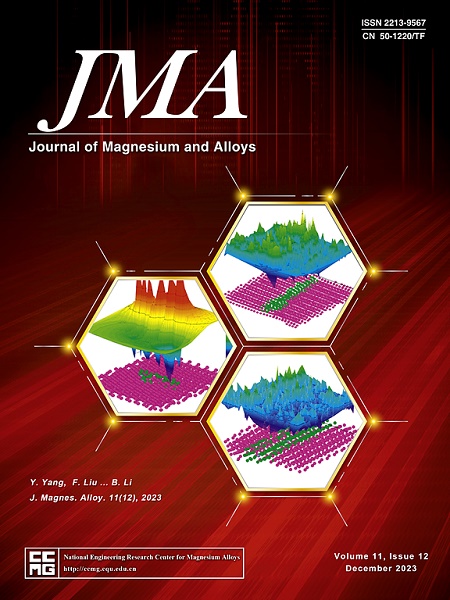Effects of composition ratio of TiCu precursor on dealloying behavior in molten Mg and microstructural characteristics of Mg-Ti composites
IF 13.8
1区 材料科学
Q1 METALLURGY & METALLURGICAL ENGINEERING
引用次数: 0
Abstract
Metal composites produced through the liquid metal dealloying (LMD) process feature an advanced matrix-matrix composite structure, where two metallic materials form a continuous, three-dimensional interconnected network. This study investigates the effects of TiCu precursor compositions on dealloying behavior and microstructural evolution in liquid Mg, using Ti50Cu50 and Ti30Cu70 precursors. The initial microstructure of the precursor significantly influences dealloying kinetics and phase transitions. The single-phase Ti50Cu50 precursor exhibits a faster initial dealloying rate due to its homogeneous structure, yet complete dealloying requires 90 min. In contrast, the dual-phase Ti30Cu70 precursor achieves complete dealloying in 30 min, demonstrating the impact of a higher Cu concentration on accelerating the process kinetics. Additionally, the study explores the coarsening behavior and hardness variations during the LMD process, along with the microstructural characteristics of Mg-Ti composites fabricated from these two precursors. The findings highlight the critical role of precursor composition in tailoring the microstructure and properties of Mg-Ti composites produced through the LMD process, demonstrating its potential for advanced composite material manufacturing.


TiCu前驱体成分配比对Mg熔液脱合金行为及Mg- ti复合材料显微组织特征的影响
通过液态金属合金化(LMD)工艺生产的金属复合材料具有先进的基体-基体复合结构,其中两种金属材料形成连续的三维互联网络。本研究以Ti50Cu50和Ti30Cu70为前驱体,研究了TiCu前驱体成分对Mg液体中脱合金行为和微观组织演变的影响。前驱体的初始组织对合金的脱合金动力学和相变有显著影响。由于其结构均匀,单相Ti50Cu50前驱体表现出更快的初始脱合金速率,但完全脱合金需要90 min。相比之下,双相Ti30Cu70前驱体在30 min内实现完全脱合金,这表明较高的Cu浓度对加速过程动力学的影响。此外,本研究还探讨了这两种前驱体在LMD过程中的粗化行为和硬度变化,以及由这两种前驱体制备的Mg-Ti复合材料的显微组织特征。研究结果强调了前驱体成分在通过LMD工艺生产的Mg-Ti复合材料的微观结构和性能方面的关键作用,展示了其在先进复合材料制造方面的潜力。
本文章由计算机程序翻译,如有差异,请以英文原文为准。
求助全文
约1分钟内获得全文
求助全文
来源期刊

Journal of Magnesium and Alloys
Engineering-Mechanics of Materials
CiteScore
20.20
自引率
14.80%
发文量
52
审稿时长
59 days
期刊介绍:
The Journal of Magnesium and Alloys serves as a global platform for both theoretical and experimental studies in magnesium science and engineering. It welcomes submissions investigating various scientific and engineering factors impacting the metallurgy, processing, microstructure, properties, and applications of magnesium and alloys. The journal covers all aspects of magnesium and alloy research, including raw materials, alloy casting, extrusion and deformation, corrosion and surface treatment, joining and machining, simulation and modeling, microstructure evolution and mechanical properties, new alloy development, magnesium-based composites, bio-materials and energy materials, applications, and recycling.
 求助内容:
求助内容: 应助结果提醒方式:
应助结果提醒方式:


